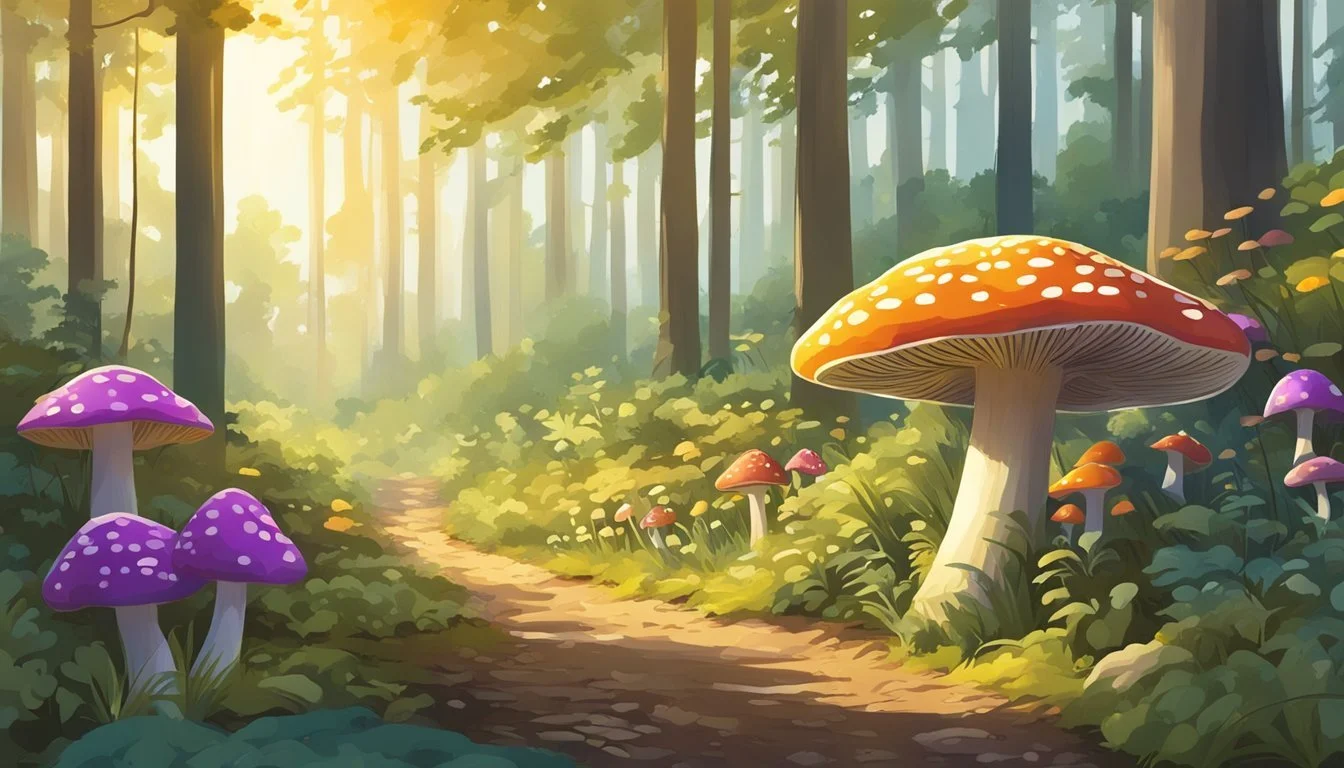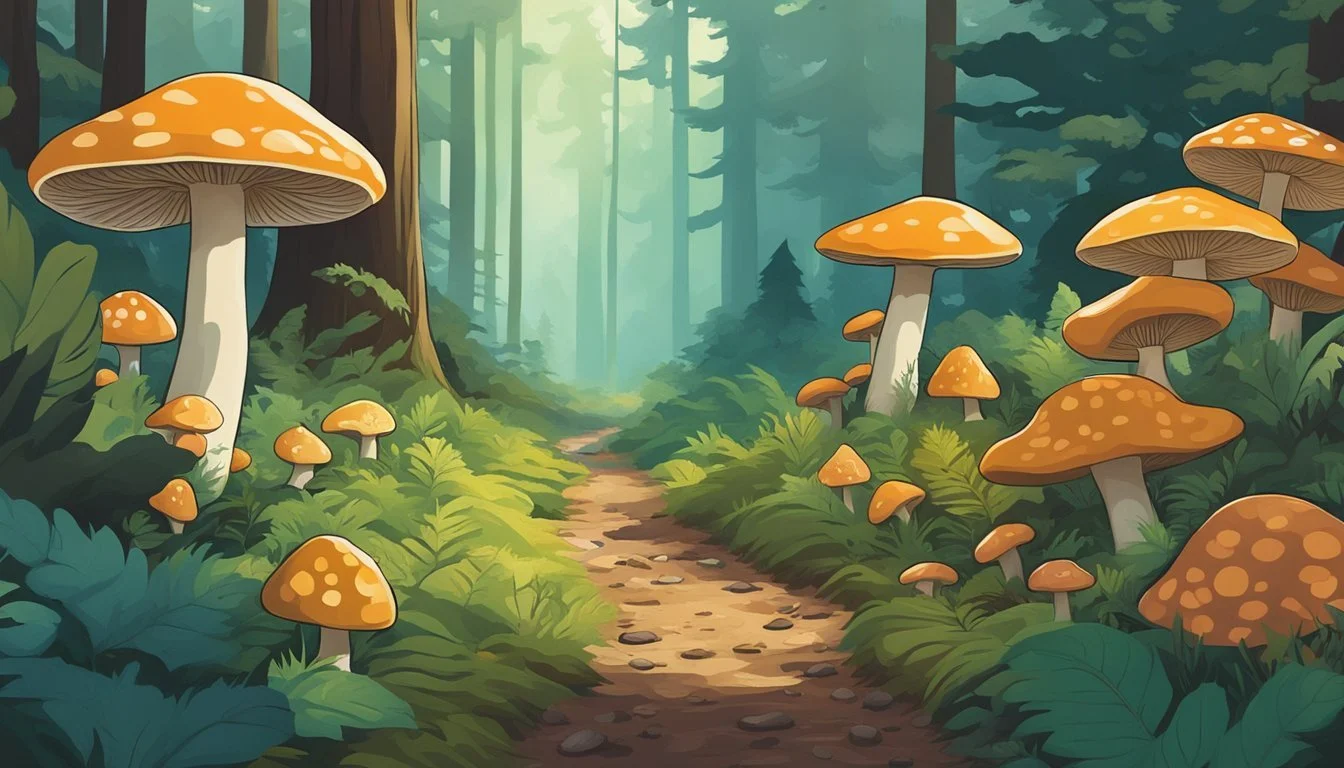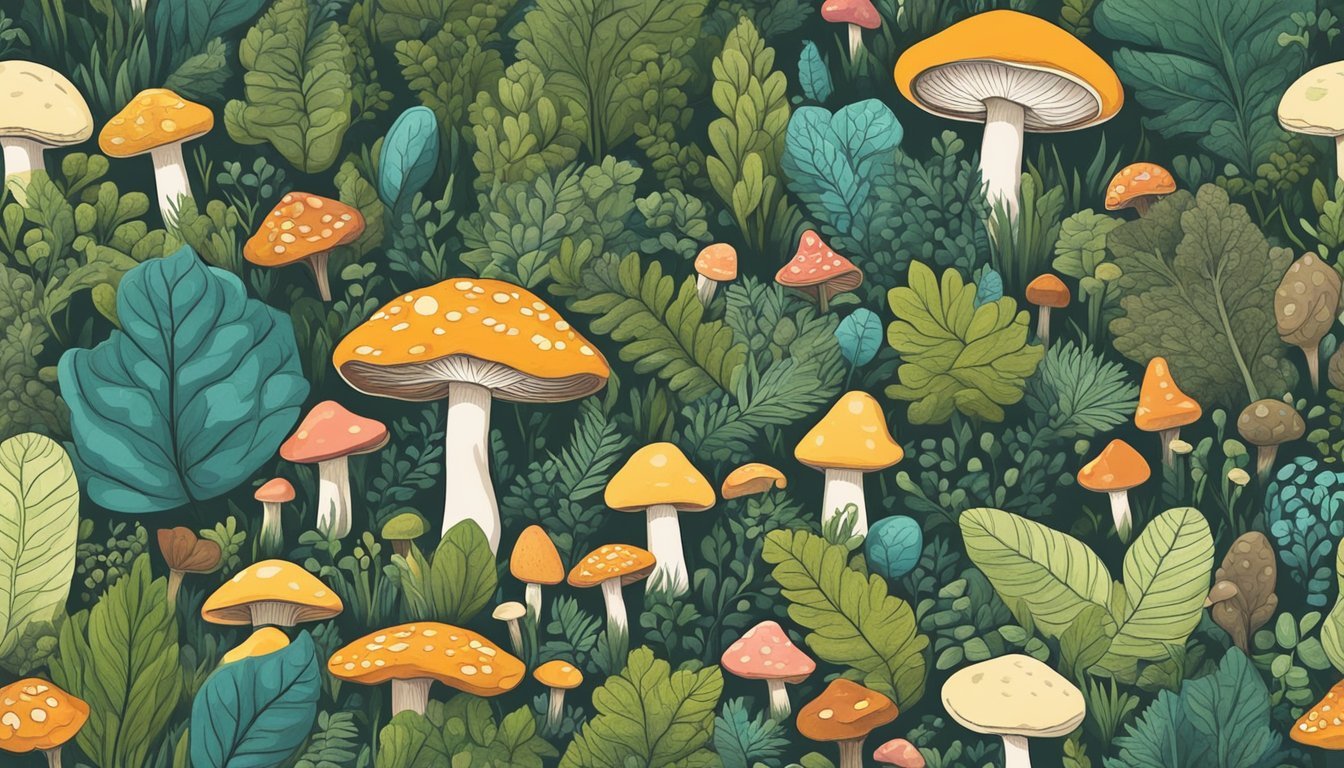Mushroom Hunting North Dakota
Seasonal Guide for Foragers
This Article is Part of Our Guide on Mushroom Hunting for All 50 States
North Dakota offers a varied landscape rich in fungi, providing an ideal environment for mushroom enthusiasts. The state's prairies, forests, and river valleys are home to a diverse range of mushroom species, each favoring different habitats and conditions. Mushroom hunting in North Dakota can be both a rewarding and educational outdoor activity, bringing people closer to nature and offering the chance to discover the many flavors and uses of local fungi.
Morel mushrooms, among the most sought after by foragers, thrive in North Dakota's unique conditions. These distinctive fungi typically emerge in the spring, following the last frost and as temperatures begin to rise. Hunters often search in areas with sandy soils, near the bases of trees such as elms, ashes, and poplars. Successful foraging requires a keen eye and knowledge of the mushroom's preferred conditions, making the hunt as thrilling as it is meticulous.
Foraging for More Than Just Mushrooms in North Dakota
North Dakota's vast prairies and woodlands offer a surprising abundance of wild edibles for the adventurous forager. While mushrooms may be a favorite, the Peace Garden State's diverse ecosystems provide a bounty of berries, nuts, roots, and greens. From the Badlands to the Turtle Mountains, discover the hidden flavors of North Dakota through the art of foraging.
👉 Foraging for Wild Edibles in North Dakota
Commonly Found Edible Mushrooms in North Dakota
North Dakota is home to several edible mushroom species. Some of the most commonly found edible mushrooms in the state include:
Morel (Morchella spp): Morel mushrooms are commonly found in North Dakota and are known for their distinctive honeycomb appearance and rich, earthy flavor.
Porcini (Boletus edulis): Found in North Dakota, porcini mushrooms have a nutty flavor and are sought after for their meaty texture, making them a popular choice for cooking.
Saffron Milk Cap (Lactarius deliciosus): These mushrooms are often found in North Dakota and are known for their vibrant orange color and peppery taste, adding a unique flavor to dishes.
Button Mushroom (Agaricus bisporus) : Commonly cultivated in North Dakota, button mushrooms have a mild flavor and versatile use in various cuisines, making them a popular choice for cooking.
It is essential to properly identify any mushroom before consuming it, as some species can be poisonous. Beginners should go mushroom hunting with an experienced guide or join a local mycological society to learn how to identify edible mushrooms safely.
Understanding the Local Ecosystem
The success of mushroom hunting in North Dakota hinges on recognizing the intricate relationships within the local ecosystems, where the combination of tree species, soil conditions, and topography determines the diversity and distribution of mushrooms.
Ecosystem and Biodiversity
Ecosystems in North Dakota are diverse, ranging from grasslands to wetlands and hardwood forests. This biodiversity is crucial as it supports a variety of fungi, which play a key role in nutrient cycling. Different mushrooms thrive in different ecosystems due to their unique ecological niches.
Grasslands often host species like the Panaeolus foenisecii.
Hardwood Forests are rich with mushroom varieties due to the diverse organic matter available.
Common Tree Species as Mushrooms' Hosts
Hardwood trees are predominant hosts for many sought-after mushrooms. Several species, such as morels and chanterelles, have symbiotic relationships with living trees or decompose the organic matter of dead ones.
Birch: Offers a habitat for species like the Birch Polypore.
Elm: Associated with morels, especially dying or dead trees.
Oak Trees: Acorns create a fertile ground for numerous fungi.
Ash: Morels have also been found in proximity to ash trees.
Hardwood Trees (General): Provide the necessary shade and organic debris for fungi growth.
Soil Type and Topography Relevance
Soil types influence the kind of mushrooms that can grow in an area due to the soil's acidity and nutrients. The topography, such as slopes and altitude, can affect the moisture and temperature, creating micro-climates suitable for certain fungi.
Loam Soils: Known for supporting a wide range of mushroom species.
Clay Soils: May be less conducive to certain types of mushrooms.
Riverbanks: Areas near rivers with mixed soils like those around aspen and cottonwood trees can be fruitful for mushroom hunters.
Slope Aspect: North-facing slopes often remain cooler and moist, favoring mushroom growth.
Identifying Edible and Poisonous Mushrooms
When mushroom hunting in North Dakota, distinguishing between edible and toxic varieties is crucial. Knowledge of mushroom morphology and an understanding of specific species can help foragers stay safe.
Characteristics of Edible Fungi
Edible mushrooms have distinct features that aid in their identification. For example, chanterelles are known for their golden-yellow color, funnel-shaped caps, and the fact that they lack true gills, instead possessing forked ridges. Morels, another edible species, are easily recognized by their honeycomb-like cap structure and hollow stem. Identifying edible fungi involves examining:
Cap shape and texture: Smooth or textured surface, unique patterns
Stem characteristics: Hollow or solid, length and thickness
Coloration: Typically consistent in edible species
Gills or ridges under the cap: The presence and pattern of gills
Toxic Mushroom Species to Avoid
Certain toxic mushrooms are common in North Dakota and should be avoided. The Death Cap (Amanita phalloides) is notoriously toxic and can be mistaken for edible species. It possesses a pale-greenish cap and white gills. Other poisonous species include various types of Amanitas, which often have a distinctive volva or bulbous cup at the base of the stem, and white spores. When identifying poisonous mushrooms, look for these features:
Cap coloring: Diversity or irregular color patterns may indicate toxicity.
Stem features: A volva or ring around the stem are warning signs.
Gills: Brightly colored or white gills can be an indicator of a toxic mushroom.
Unusual odor: Many poisonous mushrooms have an unpleasant smell.
Note: The only way to be certain a wild mushroom is not poisonous is through positive identification by an expert. If there is any doubt, it is best to leave the mushroom undisturbed.
When and Where to Find Morels in North Dakota
Discovering morel mushrooms in North Dakota requires knowledge on the best locations and times to forage. Morels, a rare and sought-after delicacy, can generally be found during the spring months.
Prime Locations for Morel Hunting
Morel mushrooms tend to flourish in specific regions of North Dakota, particularly in wooded areas and near water sources. Enthusiasts commonly report success in the following locales:
Grassy areas near the edges of forests
Riverbanks, lakesides, and streams
Forested areas with certain tree species like elms, ashes, and aspens are also conducive to morel growth. Hunters should focus on the southern regions of the state where the morel season arrives earlier due to warmer soil temperatures.
Best Times for Foraging
The prime foraging time for morel mushrooms in North Dakota is restricted to a brief window in the year. Key aspects to consider include:
Spring months, typically from May through June
Following periods of rain when the soil is wetter and not yet too hot
It's vital to embark on foraging adventures during these optimal conditions, as morels are rarely found in North Dakota outside this timeframe. Early morning hours may also increase the likelihood of a successful forage due to lower temperatures and reduced competition from other foragers.
Foraging Guidelines and Techniques
Mushroom hunting in North Dakota requires careful preparation and effective searching techniques. Knowledge of mushroom species and their respective growth conditions is vital for a safe and successful forage.
Preparation for Mushroom Hunting
Before embarking on a mushroom hunting expedition, foragers should equip themselves with a guide to identify different mushroom species. They must learn about the specific growth conditions such as soil type, acidity, and the presence of symbiotic trees that certain mushrooms, like chanterelle and morel mushrooms, favor. Foragers must ensure they carry the right tools — a basket or breathable bag to allow spores to disperse, and a thin blade to cut mushrooms, which is less damaging to the fungi's underground structures than pulling.
Effective Searching Methods
When searching for mushrooms, they should employ a systematic approach:
Start by scanning the area for obvious mushroom caps.
Look for areas where the earth is moist and rich with decomposing material, which are ideal conditions for mushroom hunting.
Check near specific trees with which certain mushrooms have a symbiotic relationship. For example, morels are often found near elm, ash, and aspen trees.
When searching for chanterelle mushrooms, seek out terrain that is both wet and well-drained; they thrive in these mixed conditions.
Use a gentle touch to forage mushrooms; avoid disturbing the surrounding area more than necessary.
For consuming mushrooms, it's paramount to identify them with absolute certainty. Since some edible mushrooms can look similar to poisonous ones, inexperienced foragers should always consult with an expert before consuming anything they gather raw or otherwise.
Utilizing Resources and Community
Mushroom hunting in North Dakota relies heavily on the use of various resources and community-driven support systems. Foragers are encouraged to utilize mushroom maps and engage with local societies to enhance their foraging experience.
Mushroom Maps and Digital Tools
Mushroom maps play a vital role for foragers in North Dakota, providing detailed insights into potential mushroom hotspots. These maps often include information on soil types, tree species, and topography, which are essential for locating edible species such as morels, chanterelles, and lion's mane mushrooms. Digital tools and applications can also assist foragers in identifying mushrooms, tracking seasonal patterns, and sharing their findings with the community.
Key Features to Look for in Mushroom Maps:
Coverage Areas: High-quality maps should cover various regions of North Dakota comprehensively.
Species Information: Look for maps that provide detailed descriptions of the mushrooms, including pictures for identification.
Terrain Detail: Maps should offer information on the local terrain to aid in navigating and discovering conducive foraging spots.
Local Foraging Events and Societies
Engagement with local foraging societies and participation in events is crucial for both novice and expert foragers. The North Dakota Mushroom Society, among other community groups, offers a platform for mushroom enthusiasts to learn and exchange knowledge. These societies often host events, workshops, and guided foraging outings, which provide invaluable hands-on experience.
Benefits of Joining Local Foraging Societies:
Education: Access to reliable information and guidance on safe mushroom foraging practices.
Networking: Opportunities to connect with fellow foragers and experts in the field.
Community Support: Availability of a supportive community that promotes responsible foraging and conservation.
Through these resources and community efforts, foragers in North Dakota can deepen their understanding of local mycology and enjoy the bountiful mushroom hunting that the state has to offer.
Culinary Applications of North Dakota Mushrooms
North Dakota offers a variety of edible mushrooms that are both delicious and versatile in the kitchen. Local foragers and chefs take delight in incorporating these local fungi into their culinary creations.
Popular Edible Mushroom Dishes
Wild mushrooms found in North Dakota, such as the prized morel and chanterelle, lend themselves to a host of dishes that highlight their unique flavors. Morels, with their earthy and nutty taste, are commonly sautéed in butter and garlic, and make an excellent addition to creamy pasta (how long does pasta last?) dishes or savory stuffings. Chanterelles, known for their slight peppery taste and firm texture, are often found in recipes like wild mushroom risotto (What wine goes well with mushroom risotto?)or as a flavorful enhancement atop a freshly baked pizza.
Here is a list of popular dishes featuring North Dakota mushrooms:
Sautéed Morels with Garlic: A simple yet classic way to enjoy the nutty flavor of morels.
Chanterelle Pizza: Fresh chanterelles sprinkled over pizza, adding a gourmet touch.
Mushroom Risotto: A creamy dish where the subtle flavors of wild mushrooms can shine.
Wild Mushroom Soup: A comforting bowl highlighting the earthiness of foraged fungi.
Cooking Tips for Wild Mushrooms
When cooking with wild mushrooms from North Dakota, one must be mindful of the correct preparation methods to maximize their culinary potential. Here are some tips:
Size Matters: Cut larger mushrooms like morels into smaller pieces for even cooking, while smaller species can typically be left whole or halved.
Heat is Key: Sear mushrooms on high heat to bring out a robust flavor and achieve a desirable texture.
Minimal Moisture: Avoid overcrowding the pan to prevent mushrooms from steaming and becoming soggy.
Iron Skillets: Use cast-iron skillets for even heat distribution and to add a bit of iron to the diet.
Pairing: Complement the slight orange hue and thin structures of chanterelles with fresh green herbs to enhance the visual appeal and taste.
Safety: Ensure proper identification of edible species before consumption to avoid health risks. Only forage mushrooms from your yard or backyard if you are confident in your identification skills.
By following these guidelines, one can elevate the natural flavors of North Dakota mushrooms and enjoy them in a variety of nutritious and savory dishes.
Conservation and Environmental Concerns
While mushroom hunting can be a rewarding activity in North Dakota, it raises important conservation and environmental concerns. Sustainable foraging practices are essential to maintain the ecosystem's balance and the diversity of species that inhabit it.
First and foremost, foragers should only harvest mushrooms they can positively identify as edible, taking care to leave behind a small portion to allow for spore dispersal and subsequent growth cycles. Disturbing or collecting rare species can have detrimental effects on the ecosystem's diversity.
Here is a checklist to promote sustainable foraging:
Identify Correctly: Always double-check the identification of mushrooms before collecting.
Harvest Responsibly: Collect in a manner that allows the fungus to continue its growth cycle.
Ecosystem Impact: Minimize your footprint; stick to paths and avoid trampling vegetation.
Foragers should adhere to local guidelines, which often reflect best practices to ensure environmental health. They should also be aware of the habitats they are entering, as different ecosystems within the United States, including North Dakota, can be sensitive to disturbances.
Education plays a vital role in conservation efforts. Foragers should seek to educate themselves about the species they are hunting and the ecosystems they inhabit. Knowledge about how mushrooms contribute to the environment can heighten awareness regarding the significance of each organism, no matter how small.
By engaging in informed and responsible mushroom foraging, the public can enjoy this activity while contributing to the preservation of North Dakota's natural resources.





